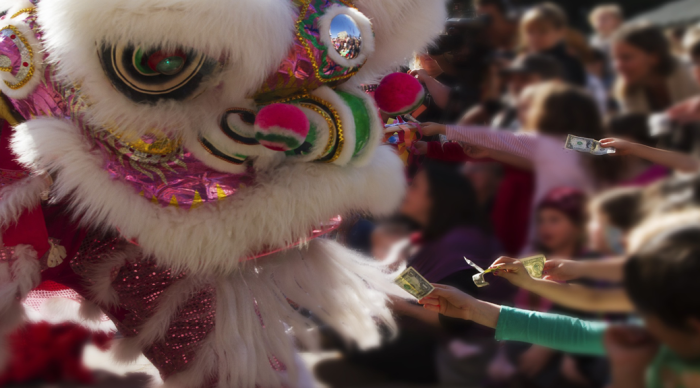
Hello one and all, it’s two days away from the Lunar New Year, so I thought I’d take the opportunity to talk about Chinese New Year and how we celebrate it here in Malaysia.
Let’s begin.
Preparations for Chinese New Year (CNY) can start as early as a month before the actual day, kindly signaled by the malls when they blast CNY songs over the speakers. It’s when spring cleaning comes to Malaysia, even though we don’t have spring. However, since Chinese New Year is also known as New Spring, it’s technically correct. It’s the time when we dust off our high pressure cleaners to clean the driveway and break out new paint cans to paint the walls. Everything has to be new or at least look new. Which also means it is clothes buying season, and red is the color of the time. Black and white clothes are avoided, since it is considered unlucky as those colors are associated with death and mourning. Some even go the extra mile to dress in traditional clothing like the cheongsam or the samfu. Similarly the house is also decked with red banners and red lanterns. Basically, red, red, red. It’s also the Year of the Fire Rooster, so there’ll be a ton of rooster decorations involved too.
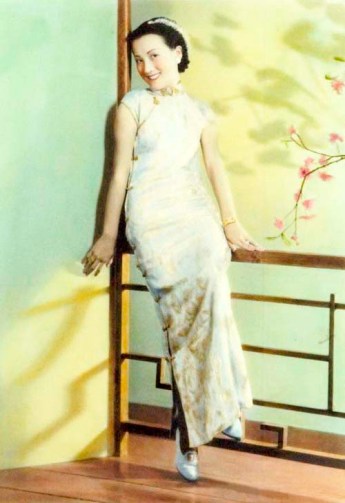
A lady in cheongsam.
Phase two of the preparations is all about food. If you’re baking cookies or cakes, it’s time to buy the ingredients and get them early because there’s often a shortage of ingredients like butter during this time of the year. Make sure you buy your chickens or ducks early too, as they can get scarce as well and prices are jacked up. And then it’s time to get those ingredients into the oven or the fryer. Some of the popular food to serve guests are the keropok, pineapple biscuits and the niangao. The keropok is a deep fried cracker often with fish or prawn flavoring and served with acar, which is spicy pickled vegetables. The pineapple biscuits are basically Jammy Dodgers except with pineapple jam. The niangao, which means year cake, is a type of steamed cake that is eaten during the New Year. It is sweet and sticky. These food are also easily available in stores and traditionally, care packages are prepared and given to relatives and close friends during this time.
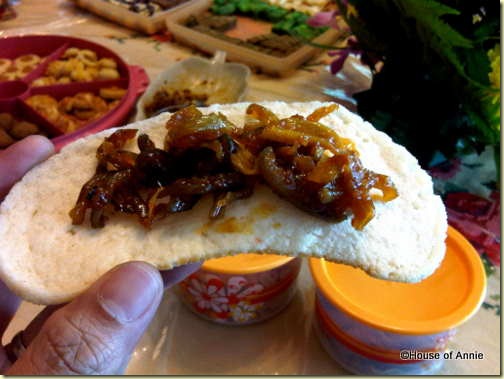
Keropok with acar (image taken from http://www.houseofannie.com)
The first major celebration of the season is Chinese New Year’s Eve. The household matriarchs often wake up early to get things started as it is a whole day of preparation for the Reunion Dinner. Sons, daughters and their families slowly trickled in throughout the day and help with the preparation. Cousins keep each other entertained while the adults catch up with one another, often while playing mahjong or blackjack. Evening finally comes and it’s time for a BIG hearty meal. There’s easily as many as ten dishes on the table. The feast begins with Yusheng, a type of fish salad, where everyone in the family basically sticks their chopsticks into the dish and start tossing it around to mix it. Fish is almost always a dish, as fish is a homonym for leftovers in Mandarin and it is believed to bring you so much abundance that you’ll have leftovers. Changshou Mian, or Long Life Noodles, is also a common dish and is eaten for longevity. Dessert often includes mandarin oranges, which is considered lucky.
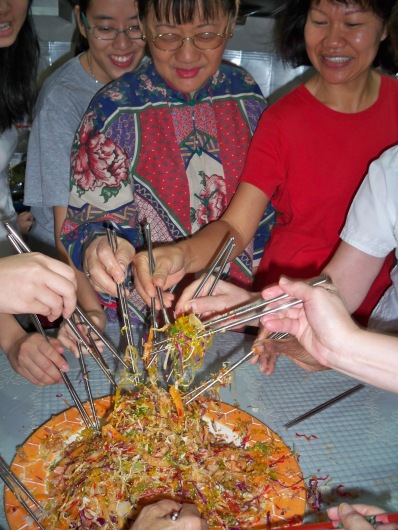
Tossing Yusheng. Kinda unhygienic if you asked me.
The night ends with fireworks, often in two sessions. Right after the Reunion Dinner and when the clock strikes midnight. Firework displays can last as long as an hour, despite being banned. To understand why fireworks are lighted, and why red color is preferred for that matter, we must go back to the origin of Chinese New Year. Tradition has it that in Ancient China, a monster known as Nian (year) comes about when spring arrives. It would terrorize people, especially children. In one village, the villagers had enough of Nian, so they figured out its weakness (the color red and loud noises) and use it to chase Nian away. They are successful and has repeated the tradition every year since.
On the first day of Chinese New Year, we deck ourselves in our newest, reddest clothes and visit family members and close relatives. The children receive their angpaos or red packets and the adults continue catching up with each other. Red packets are only given by married couples. Visitations continue in the second and third day and moves from relatives to friends as the Festive season slowly draws to a close. Lion dances also happen throughout this period. Malaysian lion dances mainly uses the Southern Chinese Lion heads, which are based on notable figures from the Three Kingdom Era, though the Northern Lions can also be seen here. Here in Malaysia, the dances are often performed by non-Chinese as the Chinese are busy celebrating CNY itself, so they pick up the slack and earn some money doing it.
The Chinese New Year season officially ends on the fifteenth day, with another festival, the Yuan Xiao Festival, or Chap Goh Mei (the Fifteenth Night) or the Lantern Festival. Not to be confused with Mid-Autumn Festival. Yuan Xiao isn’t as widely celebrated here, often only with another meal with immediate family members or not at all. But traditionally Yuan Xiao involves releasing lanterns into the air as a symbol of letting go of one’s past.
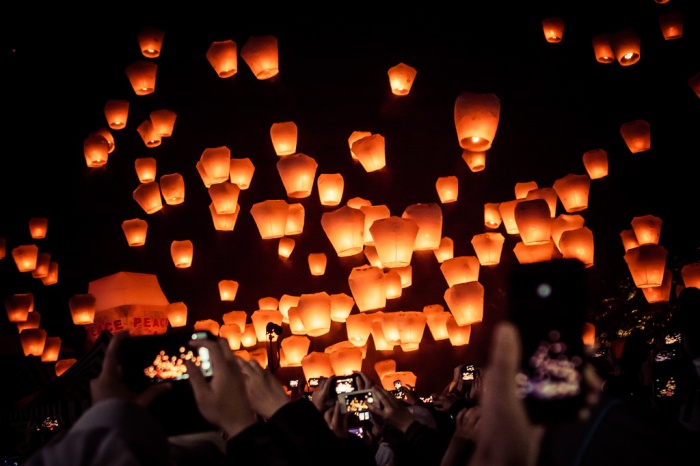
The releasing of lanterns.
There’s also throwing mandarin oranges in the river by single men and women in the apparent hopes of picking up a good spouse. Not sure how that came around. It’s also supposedly the Chinese Valentine’s Day.
And that is how Chinese New Year is celebrated here in Malaysia.
Make sure to let me know if CNY is a huge thing in your country and how it is celebrated in the comments down below 🙂



I loved this insight into CNY. It was extremely detailed and informative. Plus I learned new things. Arrrrrr!
x The Captain
LikeLiked by 1 person
Arrrrr! Glad that you enjoyed it, Captain!
LikeLike
This was such an interesting read! I’m in Canada, but the Chinese population in my area is very small compared to other areas of the country like British Columbia out west. I love that the Chinese New Year is celebrated as a season rather than just one big night of fun. The traditions seem so wonderful and thoughtful, and it’s nice to see lots of family and friends come together over many days to enjoy the company. I hope you enjoy the holiday this year! Happy Chinese New Year!
LikeLiked by 1 person
Thanks! Chinese New Year is definitely a fun season! Family is very important in Chinese culture, so it only seems fitting that the most important days of the year is spent with the family 🙂
LikeLiked by 1 person
This was such, such, such a great post! I didn’t know much about Chinese New Year until last year, to be honest. Although we have a big population of Asian people in my country, I hadn’t heard of many celebrations during this date. Probably, because, unlike on their countries, this isn’t an official holiday, so many have to work and study. It was absolutely interesting to share about the food and celebrations. I don’t know how I’d feel in one, though, since red is my least favorite color, hahah. I hope you have a great New Year, Jamie! 🙂
LikeLiked by 1 person
Thanks! I can’t imagine having to work on Chinese New Year! Many of us here even take personal leaves just to experience more of the season and recuperate a little, since the first few days are usually very hectic.
Ah, that might be a problem. There’s almost nothing but red for the CNY season. Haha. But I do hope you get to experience CNY at least once. It’s great fun if nothing else 🙂
LikeLike
Thanks for this spectacular read! Happy Chinese New Year! 😀
LikeLiked by 1 person
And thank you for reading 🙂 Hope you had a great Chinese New Year!
LikeLiked by 1 person